| Glossary | ||
| The Vertebrates | Sq |
| Vertebrates Home | Vertebrate | Vertebrate | Bones | Timescale |
For most phrases beginning with directional words, e.g. "posterior," "dorsal," "external," etc., or some generic anatomical terms, e.g., "vena," look under the next word in the phrase. However, note that this convention is not used with complete consistency in this Glossary.
Squamation the type or degree of scales on the surface of an organism or structure.
Squamosal a dermal skull bone located on the posterior "corners" of the skull. The squamosal may be primarily associated with the occiput or the skull table, or both. It often appears as a sort of transition bone which links these two major skull elements. It is closely associated with the quadrate and, in amniotes, with the temporal fenestra(e).
Squamose covered with, or made up of, scales. Sometimes mistakenly used instead of "squamous" (i.e. flat).
Squamous [1] (of a cell layer) flat, i.e. scale-like, as opposed to cuboidal or columnar. [2] (of a suture) a scalelike suture, one whose opposing margins are scalelike and overlapping. Used of sutures where one bone overlies the other with a thin, usually irregular lamina. [3] (medical, sometimes used by mammal workers) relating to the squamosal portion of the skull. Hence the squamous suture is the suture between the temporal and parietal bones. It has nothing to do with the type of suture as in definition #2.
Square Cube Law For any given shape, surface area increases in proportion to the square of any linear dimension, while volume increases as the cube. The surface area of a cube of side x is 6x2, while the volume is x3. Thus, for any given shape, doubling linear dimension will increase surface area by a factor of four and volume by a factor of eight. Biological interactions may depend on linear dimension, surface area or mass. Other things being equal (although they never are), a taller organism will be able to access vegetation in proportion to its height. The surface area over which it will lose heat from metabolizing all that fodder increases as the square of its height. The mass it has to support to get the additional height increases as the cube of the height. Thus, increasing or decreasing size requires morphological adaptations. Simply scaling up or down won't work beyond a fairly small range. As a practical matter, biological organisms are sufficiently complex that they can compensate by a series of small adaptations, including morphologically invisible behavioral adaptations, to a surprising degree. The square-cube law is therefore not quite the limitation it appears to be. Nevertheless it is an important constraint on evolution. As a point of reference, there are actually few biologically important parameters that depend on dimension. However, one of these is the force per unit cross-sectional area of muscles. "Square" interactions, those which depend on surface area, include respiratory efficiency, bone strength (i.e. cross-sectional area), aerodynamic lift, and rate of heat gain or loss to the environment, frictional resistance to motion in water, and pressure exerted on a surface. "Cube" interactions are often metabolic. Again, other things being equal, an animal twice as tall will need eight times as much energy to run at the same rate. An important, but very consistent, oddity in this respect is that larger organisms almost invariably have lower basal metabolic rates. It takes much less energy per kilogram to run a 100 kg kangaroo than a 50 g kangaroo rat.
Stance phase the phase of the locomotion cycle during which the limb is in contact with the ground (opposite of swing phase).
Standard Condition A shorthand term used in these Notes to reference a set of osteological relationships which is used as a baseline for comparative purposes. Usually the Standard Condition is established by reference to a conjectural basal amniote ("Bob"), a creature of simple osteological tastes. Occasionally, another type is used.
Stanton Formation formerly Admiral Formation or Stanton Limestone. Pennsylvanian and/or earliest Permian of Central US (Kansas). Largely marine and deltaic, but with conifer-dominated terrestrial or lacustrine component. Notably Permian-like biota, including insects and the edaphosaurid Ianthasaurus. Marine component notable for crinoids.
Stapedius muscle a small muscle of the middle ear which acts to damp excessively loud sounds by restricting the movement of the stapes
Stapes The stapes is an incarnation of the hyomandibular. It may have originally (jawless vertebrates) been the main upper element of a gill arch. It later appears as the hyomandibular, an accessory jaw element. In early tetrapods, it becomes a stout bone bracing the braincase against the quadrate. As the paroccipital process took over this function, the stapes was reduced, eventually becoming specialized for hearing as the columella, in sensible amniotes, or the stapes, in mammaliforms. The stapes bears a footplate which fits over the foramen ovale.
Stegokrotaphic "When a skull is completely roofed containing only openings for sense organs) it is called stegokrotaphic. A well-ossified skull with little kinesis is definitely an adaptation for a fossorial existence. In some rhinatrematids, scolecomorphids, and some caeciliids, the temporal region is partial open, is slightly kinetic, and is known as zygokrotaphic." Untitled Document

Stegural a membranous outgrowth of the first uroneural in the caudal fin of various fishes.
Stellate star-shaped, having points or rays like a star.
Stem group (or taxon) a clade defined as "all organisms closer to species Y than to species Z." "Stem group" or simply "stem" as an adjective, is often used more loosely to refer to the usual diverse odds and ends near the base of a radiation. In this sense, it does not describe a clade. Thus "stem tetrapods" to indicate the paraphyletic group of Baphetidae, Colosteidae, and other difficult to classify "amphibian" taxa outside the probable crown group Tetrapoda*. Other examples include the Paleoniscoids (Actinopterygian radiation), and probably Thelodonts (Vertebrate radiation).
Stenobasal having a narrow base (e.g. actinopterygian fins); opposite of eurybasal.
Stenohaline tolerating only a narrow range of salinities; opposite of euryhaline.
Stereospondylous vertebrae without an ossified pleurocentrum, although this element may be retained in a cartilaginous state. That is, the centrum is derived almost entirely from the intercentrum.
Sternal ribs In birds, the ossified gastralia which articulate dorsally on the ends of the dorsal ribs and ventrally on the sternum.
Sternebra one of the individual bones of the sternum in mammals.
Sthenaros- Greek root for strong.
stomodeum the embryonic precursor of the mouth and anterior pharynx. All vertebrates are deuterostomes. That is, the gut is formed butt-first. The mouth and pharynx are derived by a secondary invagination of superficial ectoderm -- the stomodeum. See Gilbert 2000: 490-492). Eventually, the stomodeum meets the gut endoderm and the two coalesce into a continuous tube from mouth to anus.
Stratigraphic (1) relating to vertical position in a rock column. (2) More generally, relating to relative geological age, since -- all things being equal -- older is lower in any given sequence of sedimentary rock.
Strepto- Greek root meaning reversed, backwards.
Streptostyly a special moveable hinge between the quadrate and squamosal bones in the skull... This hinge gives greater flexibility and allows the pterygoideus (jaw) muscle to exert more force. "A flexible connection at the articulation of the quadrate bone with the squamosal. This articulation allowed for mobility in the quadrate, a condition known as streptostyly." Untitled Document.
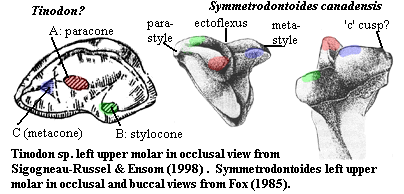
Stria (-ae) see striated. However, when used as a noun, it usually carries some of the original sense -- not merely an object with parallel lines, but with parallel lines defining or bordering a groove running between them. Differs from a sulcus in that striae are presumed to be striaght, as well as in the emphasis on the borders of the groove, rather than the furrow itself.
Striated marked with striations, i.e. thin parallel lines. From L. stria, a groove. Sometimes used in the original sense.
Stylar cusps subsidiary molar cusps developed from the cingulum. See Molars.
Styliform slender and pointed.
Stylocone generally a stylar cusp. In symmetrodonts, it refers to a particular cusp of the trigon, the B cusp at the mesiobuccal position on upper molars. See image.
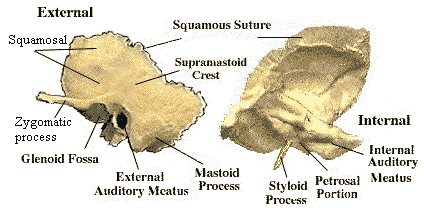
Styloid process (a) a sharp spine that projects rostroventrally from ventral surface of the temporal bone (or petrosal) just in front of the stylomastoid foramen and serves as an attachment point for various small muscles of the mouth & tongue (b) a distal process of the ulna projecting from the dorsomedial surface and attaches to a ligament of the wrist (c) a conical extension of the lateral surface of the distal radius that attaches to several tendons and ligaments. All definitions modified from STYLOID PROCESS (Search FastHealth.com) STYLOID PROCESS. Image of human left temporal bone with styloid process (a) from Dept of Anth: Temp .
Stylopodium the upper unit of the tetrapod limb, i.e., the humerus and/or femur. Same as propodium, in contrast to the lower unit, which is the zeugopodium or epipodium, and the hand or foot (autopodium).
Styrac- Greek root for spiked, spiky
Sub-prefix which used to mean "under." Now it means "more or less," "approximately," or "sort of." In other words, the writer is too gutless to commit to a description, wants to hide uncertainty or ignorance with a pseudoscientific polysyllable, or has had some nit-picking reviewer go over his manuscript with a micron caliper. Thus: "subrectangular" = square-ish, "subequal" = similar, "subparallel" = oriented kind of the same way.
Subacrodont See Tooth Implantation.
Subaponevrotic immediately under ectodermal tissue, or between ecto- and endoskeletal tissue.

Subarcuate fossa (sometimes known as the "floccular fossa") in mammaliforms, a large oval window in the petrosal which is formed by one of the semicircular canals. The literature is curiously contradictory on which one. Either the anatomy or the nomenclature is variable. See Kermack et al. (1981) (posterior); Luo (2001) (anterior). We believe the latter is correct. Kermack asserts that, in mammaliforms and early mammals, the foramen for the chorda tympani on the lateral face of the anterior lamina emerges inside the subarcuate fossa, and, in life, the fossa was probably filled with sensory nerves from the chorda tymapni, carrying taste information from the mouth. See Morganucodontidae for images and more information. More recently -- and for more recent mammals -- the subarcuate fossa has been associated with the paraflocculus, a region of the cerebellum "involved with coordination, balance, and vestibular sensory acquisition." Macrini et al. (2007).
Subashi Formation Late Cretaceous (Maastrichtian?) of China.
Subathu Formation Late Paleocene to Latest Eocene or Early Oligocene of northern India. Bajpai & Gingerich (1998). Marine. Indeterminate cetaceans.
Subinfraorbital one of the long postorbital bones in amiiform fishes. See images and explanation at Neopterygii: Overview.
Subjacent in stratigraphy, underlain by. Used to describe a stratigraphic unit which lies just below the unit being described. Opposite of superjacent.
Submandibular in Sarcopterygii, essentially the continuation of the opercular series onto the ventral face of the jaw. Sometimes referred to as "lateral gulars."
Suborbital fenestra see image at transverse flange. A fenestra in the palate located along the marginal bones at the level of the orbit. Typical of lepidosauromorphs and allies.
Subpleurodont See Tooth Implantation.
Subtemporal bar same as temporal bar.
Subtemporal fossa the (usually large) opening on the lateral margin of the palate through which the jaw adductor passes to attach to the lower jaw in tetrapods, sometimes called the adductor chamber. Teleosts have a somewhat analogous structure, with the same name, which is not homologous. Poyato-Ariza & Wenz (2002).
Subthecodont See Tooth Implantation.
Sulcate bearing grooves, grooved, groovy?.
Sulcus furrow, groove, or fissure. In Latin, 'sulcus' carries the sense of a track left by a moving body, originally a plow, but including the wake of a boat, the trail of a snake, etc.
Summerville Formation Late Jurassic of Arizona, Utah and Colorado. Part of the San Rafael Group. Unfossiliferous except for ichnofossils. Red to chocolate, sandy mudstone. Tidal flats? Deposited in shallow, quiet marine waters.
Sundance Formation mJ (Bathonian?) of Wyoming and Utah ~167 Mya.. Shallow marine and nearshore. Pterosaur and dinosaur tracks.
Superior vestibular nerve a branch of the auditory (VIIIth) nerve which communicates information from the lateral semicircular canal.
Superjacent in stratigraphy, overlain by. Used to describe a stratigraphic unit which lies just above the unit being described. Opposite of subjacent.
Superognathal (adj) relating to the upper jaw; (n) the bone "tooth" plate(s) on the upper jaw of placoderms.
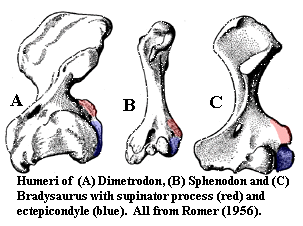
Supinate rotation of hands or feet so that the palmar or plantar surface faces more inward. This word is used by different people in slightly variant ways peculiar to their interests. In medicine, it typically refers to turning the palms upward or forward. In sports medicine or physical therapy it usually refers to the angle of the feet with respect to the substrate. The latter is a bit closer to the typical use in paleontology. Most tetrapods have a sprawling or semi-sprawling stance, so that static supination is required to exert force on the outside of the hands or feet and avoid a belly flop with each step. As the stance approaches a more erect carriage, supination can also be substituted for limb retraction as part of the power stroke. If this sounds complicated, it is. But stand on one leg and then rotate onto the outside of the foot, and you'll see the significance.
Supinator (muscle) a muscle which originates on the distal humerus, inserts on the radius and accomplishes supination (rotation of the wrist).
Supinator process a ridge or tuburcule on the anterodistal part of the humerus, usually just proximal to the ectepicondyle, from which it may be separated by a groove or fenestra, the ectepicondylar foramen. supinator muscle originates on the supinator process. See also Humerus.
Supraacetabular shelf a shelf or ridge on the ilium, along the dorsal edge of the acetabulum.
Supracleithrum a paired bone of the sarcopterygian skull and shoulder girdle. The supracleithra bridged the posttemporals dorsomedially) to the cleithrum (ventrolaterally). See Eusthenopteron for an image of the whole series. The supracleithra are lost in all tetrapods.
Supracoracoideus A muscle which, in birds, is primarily involved in the recovery stroke. The supracoracoideus attaches on the sternum and acts on a tendon which passes over the top of the glenoid through the triosseal canal and insert dorsally on the humerus. It thus exerts a pulley-like force which raises and rotates the humerus. The contractile properties of the M. supracoracoideus in the pigeon and starling: a case for long-axis rotation of the humerus.
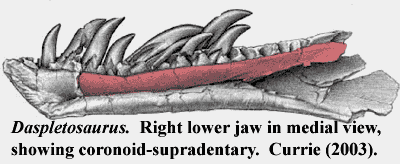
Supradentary some theropod dinosaurs re-invented the row of coronoids that reinforced the edges of the lower jaw in sarcopterygian fishes and early tetrapods. In theropods, this took the form of a neomorphic supradentary which was formed as an extension of the one remaining coronoid.
Supraglenoid buttress"At the back of the lower portion of the scapular blade, above the anterior portion of the glenoid cavity, is a thickened triangular region which we may term the supraglenoid buttress. This is perforated by the supraglenoid foramen, presumably carrying blood vessels and possibly nerves of the brachial plexus." Romer 1956: 307).
Supraglenoid foramen see Supraglenoid buttress. Unfortunately, there is a structure with the same name associated with the glenoid involved in jaw attachment.
Supraneural spines "Large blade-like supraneural spines are present above neural arches 1, 3, and 5, but not 2 or 4. The supraneural spines supported a muscular complex involved in feeding not only through raising the snout, but also by depression of the lower jaws induced by the forward swing of the quadrate. Flexion of the intracranial joint is likely responsible for the initiation of jaw closure during feeding." See Hitchcock. Also present in the tail to support the tail fin. Acanthostega gunnari. Generally, supraneurals are dermal bones which extend the line of the neural arch spines. Unlike epineurals, they are thought to be autogenous neural spine elements, not separate endochondral elements formed from myoseptal cartilages.
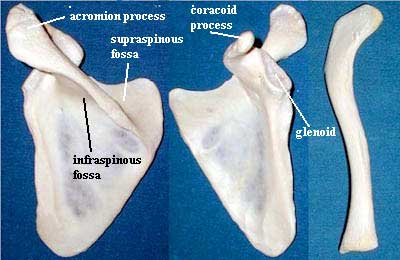
Supraoccipital One of the bones of the occiput, the part of the skull which articulates with the spine. The supraoccipital is located (if present) dorsal to the foramen magnum. It is frequently fused with the opisthotic bone to form a large horizontal bar across the back of the skull, separating the rest of the occiput from the dermal bones on the roof of the skull -- typically the parietals or postparietals. It sometimes participates in the foramen magnum. The supraoccipital seems to have developed from a dorsal ligament joining the otic capsules, early in tetrapod evolution. See The Occiput for details.
Suprapterygoid articulation of the palatoquadrate. One of the possible dorsal articulations of the palatoquadrate in which the palatoquadrate articulates with a suprapterygoid process of the ethmoid, more or less directly dorsal to the basipterygoid process near the dorsal margin of the ethmoid. See image at paratemporal articulation.
Suprapterygoid process see suprapterygoid articulation, supra.
Supraspinous fossa In mammals, the scapula is divided by a prominent ridge, the scapular spine. The dorsal (upper in bipeds) division is concave and is referred to as the supraspinous fossa. See image.
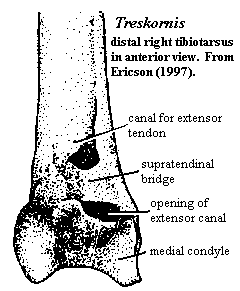
Supratemporal The skull table of basal osteichthyans had not only the usual series of paired mid-line bones (frontals, parietals, and postparietals), but a series of bones lateral to them. These, from anterior to posterior, were the infratemporal, supratemporal, and tabular. These accessory skull table bones persisted into the early amniotes, but were convergently lost in all lineages. In actinopterygians, the pterotic or dermopterotic is probably homologous to the supratemporal bone, but we wouldn't swear to it. The supratemporal in fishes can often be recognized by its close relationship with the spiracle and the presence of a commissure (i.e. junction) of the lateral line system. For an example, see Grossius.
Supratendinal bridge could refer to any bony bridge over a tendon. Particularly, the bridge over the extensor canal at the distal end of the tibiotarsus of certain birds. The presence of the bridge and the position of the canal opening relative to the condyles may have phylogenetic significance. Ericson (1997).
SurangularSee Bones: The Surangular
Suspensorium (1) the arrangement of bones which supports the jaw from the braincase; (2) in teleost fish, a large, usually triangular, bone which supports the jaw. The teleost suspensorium is formed by fusion of various elements which vary among different taxa. See Gill Arch Derivatives.
Sustentacular facet the convex articular surface of the astragalus which inserts on a concavity of the sustentaculum, a medial process of the calcaneum.
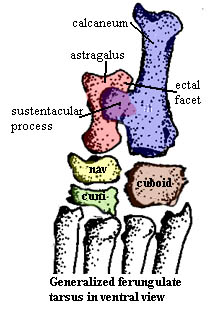
Sustentaculum (= sustentaculum tali = sustentacular process) a medial process of the calcaneum which articulates with the astragalus.
Swing phase [1] the phase of the locomotor cycle during which the limb is not in contact with the ground (opposite of stance phase). [2] A particularly unfortunate episode in the general decline of orchestral music.
Symphysis area where two paired bones meet and articulate, particularly the bones of the lower jaw (i.e., the "mandibular symphysis", "jaw symphysis").
Synapophysis fusion of the articular heads of a rib into a single elongate articulating surface.
Synapomorphy a character which is shared by all basal members of a clade and is derived from their common ancestor. A synapomorphy may be secondarily lost in later descendants. Only a synapomorphy may be used to infer phylogeny.
Synapophysis of ribs, an intermediate between single (holocephalous) and double-headed (dichocephalous) ribs, in which the rib articulates with the vertebral column by a single, broad head, or two heads not distinctly separated.
Synarcual a group of fused anterior vertebrae. The synarcual is normally at the anterior end of the vertebral column and is involved in the articulation of the head.
Synarthrodial immoveable joints, such as sutural connections, as opposed to slightly moveable (amphiarthrodial) or fully moveable (diarthrodial), such as the back and knee joints, respectively.
Synarthrosis A form of articulation in which the bones are rigidly joined by fibrous tissue. More generally, any "immovable joint." More generally yet, any immovable articulation between bones. Most likely, it originally referred to a condition in which one bone grew to match exactly the complex articulating surface of another. That is, it was a reference to a developmental event, rather than an anatomical structure. As matters stand, it has become a rather useless word suited best for taking up space in glossaries.
Synchondral same as synchondrosal.
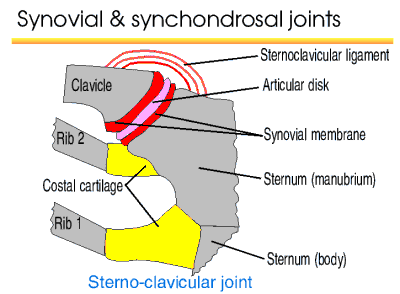
Synchondrosal "joint" where two bones are flexibly joined by a length of cartilage, the resulting structure has a variable amount of mobility, and the join is referred to as a synchondrosal joint.
Syndactylous Pertaining to two or more digits that are fused together or, in mammals, are encased in the same fleshy covering.
Syndesmotic relating to an articulation in which the bones are joined by ligaments.
Synostosis in paleontology, more or less identical to fusion of bones. It differs, if at all, in referring specifically to the case in which two bones are fused in such a way that there is no intervening periosteal layer -- which is normally what one means by "fusion" anyway. In human medicine, synostosis refers to the premature or pathological fusion of bones during development and is the cause of genuinely sad and painful facial deformities.
Synotic tectum in tetrapods, the otic capsules are joined dorsally by an embryonic membrane which may ossify in whole or in part. In at least some forms, this seems to be the origin of the unpaired median supraoccipital. See Berman 2000).
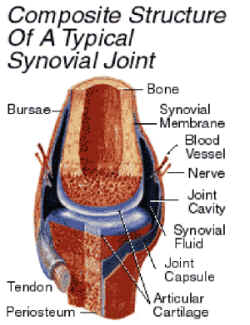
Synovial joint a joint with the following characteristics: (a) the articulating bones are separate, (b) the bones are held together by a cuff of fibrous tissue, c) the capsule is lined by synovial membrane, (d) the articulating surfaces are covered by cartilage, usually hyaline (but can be fibrocartilage, as in the temporomandibular joint), and (e) there is synovial fluid between the articulating bones.
Synsacrum A sacrum enhanced by incorporation of additional fused?) caudal or dorsal (lumbar) vertebrae.
Syntype Each specimen of a type series from which neither a holotype nor a lectotype has been designated.
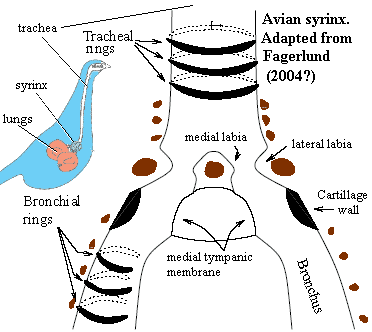
Syrinx (pl. syringes) in birds, a structure analogous to voice box of humans, located low on the trachea and/or on the bronchi. Sound is produced either through vibration of the labia or the medial tympanum, or some combination of the two. It is modulated by cartilaginous rings in the tracheae, by C-shaped cartilages in the bronchi, or by both. The location of the modulating cartilages is used to classify the syrinx as, e.g., a tracheobronchial syrinx. Fagerlund 2004?).